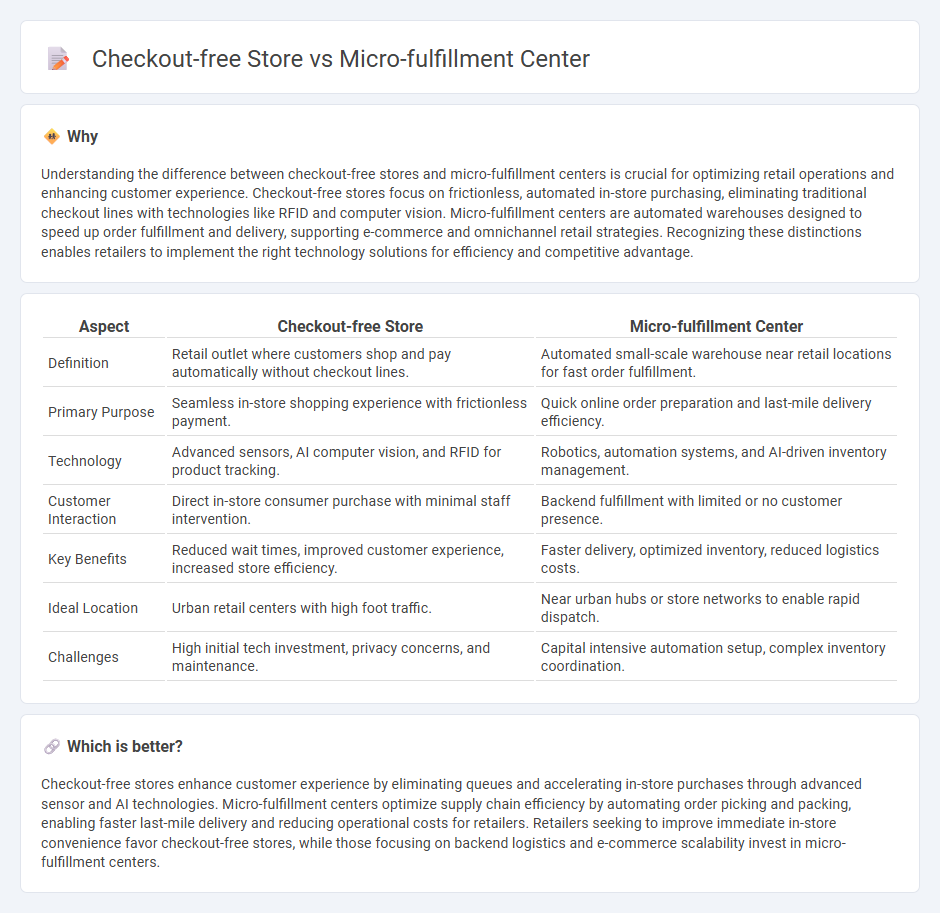
Checkout-free stores leverage advanced sensor technology and AI to enable seamless, cashier-less shopping, enhancing customer convenience and reducing wait times. Micro-fulfillment centers use automated robotics and streamlined storage systems to accelerate order processing and optimize inventory management for e-commerce. Discover how these innovations are transforming the retail landscape and reshaping consumer experiences.
Why it is important
Understanding the difference between checkout-free stores and micro-fulfillment centers is crucial for optimizing retail operations and enhancing customer experience. Checkout-free stores focus on frictionless, automated in-store purchasing, eliminating traditional checkout lines with technologies like RFID and computer vision. Micro-fulfillment centers are automated warehouses designed to speed up order fulfillment and delivery, supporting e-commerce and omnichannel retail strategies. Recognizing these distinctions enables retailers to implement the right technology solutions for efficiency and competitive advantage.
Comparison Table
| Aspect | Checkout-free Store | Micro-fulfillment Center |
|---|---|---|
| Definition | Retail outlet where customers shop and pay automatically without checkout lines. | Automated small-scale warehouse near retail locations for fast order fulfillment. |
| Primary Purpose | Seamless in-store shopping experience with frictionless payment. | Quick online order preparation and last-mile delivery efficiency. |
| Technology | Advanced sensors, AI computer vision, and RFID for product tracking. | Robotics, automation systems, and AI-driven inventory management. |
| Customer Interaction | Direct in-store consumer purchase with minimal staff intervention. | Backend fulfillment with limited or no customer presence. |
| Key Benefits | Reduced wait times, improved customer experience, increased store efficiency. | Faster delivery, optimized inventory, reduced logistics costs. |
| Ideal Location | Urban retail centers with high foot traffic. | Near urban hubs or store networks to enable rapid dispatch. |
| Challenges | High initial tech investment, privacy concerns, and maintenance. | Capital intensive automation setup, complex inventory coordination. |
Which is better?
Checkout-free stores enhance customer experience by eliminating queues and accelerating in-store purchases through advanced sensor and AI technologies. Micro-fulfillment centers optimize supply chain efficiency by automating order picking and packing, enabling faster last-mile delivery and reducing operational costs for retailers. Retailers seeking to improve immediate in-store convenience favor checkout-free stores, while those focusing on backend logistics and e-commerce scalability invest in micro-fulfillment centers.
Connection
Checkout-free stores leverage advanced sensor technology and AI to enable seamless, cashier-less shopping experiences, which significantly increases the need for rapid inventory replenishment. Micro-fulfillment centers (MFCs) complement this model by providing localized, automated storage and order processing capabilities that reduce delivery times and optimize stock management. Together, checkout-free stores and MFCs create a synergistic retail ecosystem that enhances operational efficiency and meets consumer demand for convenience.
Key Terms
Automation
Micro-fulfillment centers utilize advanced robotics and AI to efficiently store, pick, and pack online grocery orders within urban areas, significantly reducing delivery times and labor costs. Checkout-free stores leverage computer vision, sensors, and AI to enable seamless, cashier-less shopping experiences by automatically detecting items taken by customers and charging them upon exit, enhancing convenience and reducing checkout friction. Explore the latest innovations and benefits of automation in retail by learning more about these technologies.
Inventory Management
Micro-fulfillment centers optimize inventory management through automated storage and rapid item retrieval, significantly reducing picking errors and enhancing order accuracy. Checkout-free stores utilize real-time inventory tracking via sensors and AI-powered cameras, minimizing stockouts and ensuring seamless product availability for customers. Explore these innovative retail solutions to understand their impact on inventory efficiency and customer experience.
Customer Experience
Micro-fulfillment centers streamline order processing with automated systems that accelerate delivery times and ensure accurate inventory management, enhancing overall customer satisfaction. Checkout-free stores eliminate the friction of traditional checkout by using sensors and AI to enable seamless, cashier-free shopping experiences, increasing convenience and reducing wait times. Explore how these innovations transform retail customer experience in detail.
Source and External Links
Micro-Fulfillment Explained: Key Benefits and Strategies for ... - Micro-fulfillment centers (MFCs) are small, highly efficient warehouses located close to urban consumers, typically 3,000 to 10,000 square feet in size, designed to accelerate order fulfillment by storing high-demand items for rapid delivery and reducing last-mile delivery times and costs.
What Are Micro Fulfillment Centers? - City National Bank - Micro-fulfillment centers operate at a much smaller scale than traditional warehouses, focusing on rapid shipping of a select assortment of products with turnover rates of 8 to 10 times per year, often adopting automation and robotics to meet growing e-commerce demand, particularly in grocery retail.
Micro fulfillment center: How it helps retailers speed up fulfillment - These centers are typically embedded in or near urban retail spaces to provide fast delivery and convenient fulfillment options like curbside pickup, usually storing only 24-48 hours' worth of inventory and leveraging automation technology to boost operational efficiency.
 dowidth.com
dowidth.com